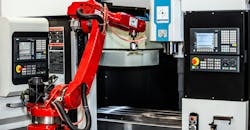3 Scenarios for Lights‐Out Automation in Post‐Covid Manufacturing
We are a full year into the COVID‐19 pandemic and its related impact on manufacturing, and we are starting to see a return to normalcy – a new normal – that includes social distancing and safer‐at‐work strategies. As COVID‐19 capacity constraints and social-distancing requirements seem to be fixtures in manufacturing now, there is a new interest in lights‐out automation.
Lights‐out automation -- where machines run unattended and/or remotely -- makes it possible to maintain production with minimal or zero human involvement. Automation increases the visibility of operations at critical points of the manufacturing process. During last year’s shutdowns, manufacturers that enabled lights‐out manufacturing shined as positive examples of business continuity.
Because robotics and other machines can run in the dark and under a wide range of temperatures, one frequently cited benefit of lights‐out automation is savings in lighting, heating, and cooling. Given the cost of the transition, a lights‐out automation program will not pay for itself in less than a couple of years.
Another argument for introducing lights‐out automation is improved capacity, for example, saving space with auto‐retrieval. To date, most automated retrieval systems have remained prohibitively expensive and have proven to be problematic unless used under highly predictable and repetitive operations. What’s more, they often require skilled human operators to fulfill the kinds of tasks that involve adjustments and on‐the‐fly thinking. With humans still needed in the loop, the value proposition of reducing space, at this time, is counter to COVID‐19 compliance and physical distancing requirements.
In general, while a large‐scale lights‐out automation strategy may make sense for large manufacturers, for machine shops it's often far too costly. There are three specific scenarios, however, where it makes sense to implement lights-out automation in the machine shop:
Working around skilled labor shortages. According to the World Economic Forum, 2020 was the year that automation started taking over the workforce, due to the ongoing and widening skilled labor shortage in manufacturing. This makes it one of the biggest factors in deciding to automate, to address the need for truly advanced automation that can fill highly specialized (if still repetitive) tasks.
As production picks up, 61% of manufacturing companies will develop hybrid models, using more automated, less human‐intensive processes, according to Deloitte. One challenge is upskilling employees to work in these more technology‐oriented environments. As a result, 41% of manufacturers already have started to form new relationships (i.e., partnering with technical schools) to develop a more robust talent ecosystem.
Supporting high‐volume production. Scenarios where production volumes are so high that a human workforce could not achieve the quota, require automation. This could be the case when millions of the same or a few parts are required, or in which many thousands of tests are required. Robotic work cells are an example of a hybrid lights‐out automation model relegated to a specific area or plant process, and some manufacturers are looking at a shift‐model, where the night shift is automated with a robot workforce to supplement the human workforce that arrives in the morning.
Minimizing contamination. Scenarios where automation has already been in place for years include manufacturing films, semiconductors, and pharmaceuticals, among other products. All these are areas where high-quality and even lights‐out conditions are required to minimize the introduction of various types of contaminants, and/or where production environments involve hazardous materials that introduce risks to human safety.
Consider Alternative Automation Strategies
As lockdowns are lifted, manufacturers must look to technology‐enabled strategies to support social distancing and related safer‐at‐work practices. Here, automation can provide a solution to labor capacity constraints. According to McKinsey, at one industrial manufacturing company, robots deliver raw materials and semi‐finished goods to different production lines, helping supplement the reduced workforce while eliminating close contact between production and material‐handling employees.
The path to automation starts with accurate data, which is enabled via enterprise resource planning (ERP) solutions. From remote monitoring that allows access to real‐time data, to drag‐and‐drop job scheduling that eliminates costly down‐time and assists with planning preventative maintenance, as well as identifying the reasons for machine downtime, automation augmented with ERP is a winning solution that provides value to both large and small manufacturers.
Manufacturers are returning to work with safer‐at‐work policies that likely will guide new-normal, go‐forward operations, which can go a long way toward preparing the industry for further shutdowns and future pandemics. Now is the time to start planning for the future. Strategic machine shops will move forward with automation and effectively using ERP, machine learning and related technologies to succeed in the post‐COVID manufacturing era.
Paul Denmark is a senior consultant at Ultra Consultants with specific industry expertise in medical device, aerospace and defense, oil and gas, and consumer electronics, as well as pressure sensitive adhesive industries.
About the Author
Paul Denmark
Senior Consultant
Paul Denmark is a senior consultant at Ultra Consultants with specific industry expertise in medical device, aerospace and defense, oil and gas, and consumer electronics, as well as pressure sensitive adhesive industries.
